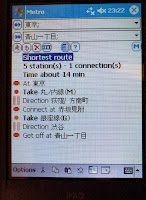We got some for our laptops. Check out the rabbits viewing the moon on the Mac and the maneki neko with bells and coins on the HP netbook.


Have you been studying Japanese? Are you ready to try to tour Japan independently? Here's how we travel. Maybe you can learn from our mistakes and little victories.


 When staying at a Ryokan (Japanese inn), or Minshuku (bed & breakfast) it's worthwhile to get breakfast if it's offered. The food usually comes in many small dishes, and the contents of these dishes varies from lodging to lodging and region to region. If there's something you can't figure out how to eat you can always ask your hosts 「これの食べ方はどうですか。」- "How is this eaten?". When you are done, don't forget to tell them - 「ごちそうさまでした」- "It was a feast".
When staying at a Ryokan (Japanese inn), or Minshuku (bed & breakfast) it's worthwhile to get breakfast if it's offered. The food usually comes in many small dishes, and the contents of these dishes varies from lodging to lodging and region to region. If there's something you can't figure out how to eat you can always ask your hosts 「これの食べ方はどうですか。」- "How is this eaten?". When you are done, don't forget to tell them - 「ごちそうさまでした」- "It was a feast". Self-serve bakeries are another good place to get a quick breakfast. These shops are often near train stations, and usually don't have a place for you to sit and eat. If they do have a seating area and you wish to use it, you are sometimes expected to buy a beverage. You will know this because they will ask you 「お飲み物は…」- "and to drink...?" At the entrance there will be a stack of trays and a box of tongs. Grab a tray and tongs, then select what ever looks good to you. メロンパン - Melon bread and あんパン - buns stuffed with sweet bean paste are always good. For something more heartier you can get ウイナー - pup in a blanket.
Self-serve bakeries are another good place to get a quick breakfast. These shops are often near train stations, and usually don't have a place for you to sit and eat. If they do have a seating area and you wish to use it, you are sometimes expected to buy a beverage. You will know this because they will ask you 「お飲み物は…」- "and to drink...?" At the entrance there will be a stack of trays and a box of tongs. Grab a tray and tongs, then select what ever looks good to you. メロンパン - Melon bread and あんパン - buns stuffed with sweet bean paste are always good. For something more heartier you can get ウイナー - pup in a blanket.

 Airline type carry-on cases work pretty well, but may not quite fit in some coin-lockers. Even though the cases are basically soft-sided, many have some rigid pieces in the wheels or the extending handles. In most cases a 21 X 14 X 9 inch bag will fit into lockers designed for carry-ons, but in a few cases, the bags didn't fit and you'll have to pay for a larger locker. Don't give up to quickly on the smaller locker, though. Sometimes you can insert your bag horizontally, then rotate, applying some topological gymnastics to get it to fit.
Airline type carry-on cases work pretty well, but may not quite fit in some coin-lockers. Even though the cases are basically soft-sided, many have some rigid pieces in the wheels or the extending handles. In most cases a 21 X 14 X 9 inch bag will fit into lockers designed for carry-ons, but in a few cases, the bags didn't fit and you'll have to pay for a larger locker. Don't give up to quickly on the smaller locker, though. Sometimes you can insert your bag horizontally, then rotate, applying some topological gymnastics to get it to fit.


 Metro is to local travel what Hyperdia is to inter-city travel. This is a free application you can get from http://metro.nanika.net/ . It's pretty easy to use; just enter you departure point and destination and it will plan your route. Selectable transportation modes include buses, trains, streetcars, and even a ropeway. It will give you two routes: the fastest, and the one with the least connections. At least on the versions I've tried, it's not aware of departure times or fares, but buses and trains are usually frequent enough that it doesn't matter much.
Metro is to local travel what Hyperdia is to inter-city travel. This is a free application you can get from http://metro.nanika.net/ . It's pretty easy to use; just enter you departure point and destination and it will plan your route. Selectable transportation modes include buses, trains, streetcars, and even a ropeway. It will give you two routes: the fastest, and the one with the least connections. At least on the versions I've tried, it's not aware of departure times or fares, but buses and trains are usually frequent enough that it doesn't matter much.